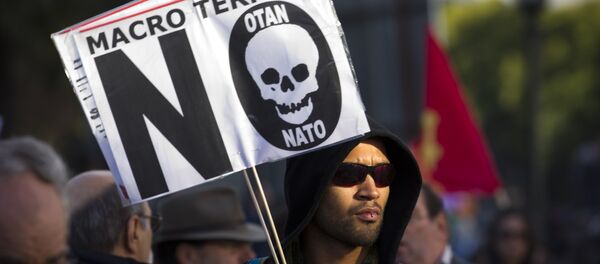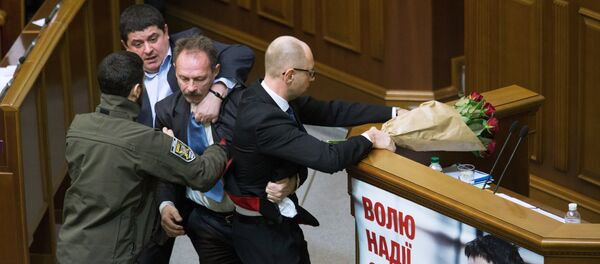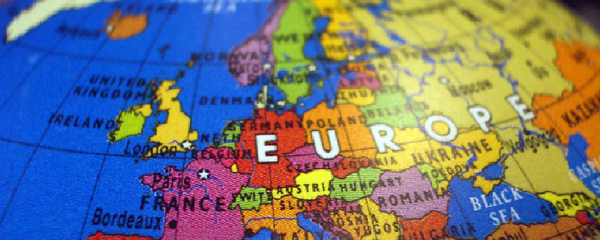Moscow maintains that NATO’s eastward expansion, highlighted by the invitation extended to Montenegro to become its 29th member, undermines the European security architecture and threatens Russian national security. A US plan to deploy ballistic missile defense systems in Eastern Europe provoked a negative response from Moscow, while the downing of a Russian jet by the Turkish military poured gasoline on the fire.
Below is a review of key events contributing to the persistent threats, misinterpretations, near-misses and outright aggression that have come to characterize the two players’ relations.
Ukraine's Stilted March to NATO
The year began with French President Francois Hollande relaying Russian President Vladimir Putin’s assurances early in January that eastern Ukraine was not under threat of a Russian invasion.
The following month, Russian Presidential Aide Yuri Ushakov welcomed Paris' opposition to Kiev's potential NATO membership.
Late in May, Ukrainian President Petro Poroshenko signed off on a new national security strategy, which sets out the conditions for successful European integration and accession to NATO. A new military doctrine adopted in September prioritized deeper cooperation with NATO, specifically, making the national military fully compatible with NATO forces by 2020.
A 2020 referendum is expected to gauge public support for NATO membership. Poroshenko pledged to launch a NATO bid if the move is backed by a majority vote. A petition to hold a referendum on Ukraine’s accession to NATO surpassed the 25,000-signature threshold in November, requiring Poroshenko to take it into consideration.
The military alliance itself made overtures to Kiev throughout the year, vowing solidarity and other forms of support.
NATO Secretary General Jens Stoltenberg threw cold water on Kiev’s NATO aspirations in February, saying the alliance "strongly believes in partnership…but many partnerships never end in membership."
In June, he stressed that a complete overhaul to its state apparatus stood between Ukraine and its application to join NATO.
In early 2015, Putin called the Ukrainian armed forces a "NATO-controlled foreign legion, which is not serving to protect Ukraine's national interests."
Dead Link in Russia-NATO Contacts
After the bloc cut military and civilian ties with Russia over Crimea and the conflict in eastern Ukraine, NATO’s leadership signaled its willingness to restore lines of communication in January 2015.
Russian Permanent Representative to NATO Alexander Grushko acknowledged the signals and called on Brussels to take the first step.
"It wasn't us who cut off these communication lines, so if NATO seriously believes that a military dialogue is a serious stabilizing factor, then it should make the first step in restoring normal dialogue that existed between us as part of the Russia-NATO Council for many years."
Throughout the year, a number of high-ranking Russian defense and diplomatic officials declared Moscow's readiness to resume communication with the alliance, on the condition that relations were on an equal footing.
The Russian mission to NATO’s website listed 30 military and civilian staff as working for it by late 2015, down from the 37 it had months earlier.
In June, US Defense Secretary Ashton Carter bleakly assessed that US-led NATO’s rift with Russia "might not change under Vladimir Putin, or even thereafter."
The assessment came months after Russian Foreign Minister Sergei Lavrov expressed Moscow's readiness to restore ties once the Western alliance was ready to do so.
For its part, Russia suspended its participation in the joint consultative group dealing with the Treaty on Conventional Armed Forces in Europe (CFE), effective from March 11.
"NATO countries continue to find loopholes in the CFE through the alliance's expansion, simultaneously delaying ratification of the Adapted CFE treaty under various pretexts," the Russian Foreign Ministry argued in its statement to announce its decision.
NATO abstained from ratifying an updated CFE treaty limiting each bloc on five key categories of conventional armaments and military hardware in 2007.
The single positive development in NATO-Russia ties during the course of the year was the establishment of a first post-cold War direct military-to-military communication link on May 3. The idea for the hotline was reportedly originated with Germany, as a means of responding to potential crises in the Ukrainian conflict.
Border Drills in Russia's Backyard
The intimidating and all-encompassing Allied Shield summer maneuvers incorporated drills with similarly menacing titles: Trident Joust, BALTOPS, Saber Strike and Noble Jump.
Throughout June, a total of 15,000 servicemen from 22 member and non-member countries were deployed across Poland, Romania, Bulgaria and in three Baltic nations directly bordering Russia: Estonia, Latvia and Lithuania.
The Noble Jump exercise was held in Poland to train NATO's new "Spearhead" Very High Readiness Joint Task Force (VJTF), which is a part of Alliance’s larger NATO Response Force.
In addition to the Allied Shield umbrella, a number of NATO members held drills, which either clearly or implicitly stated that they were being held in response to perceived Russian aggression.
Trident Juncture – NATO’s largest exercise in over a decade – took place in October and November across southwestern Europe with the involvement of 36,000 troops, 140 aircraft, 90 vessels and submarines from over 30 countries.
The drills took place against a backdrop of vocal rallies across the European Union in opposition to the military bloc.
In November, in response to a question on whether the drills were targeted against Russia, Stoltenberg said Trident Juncture was intended to send a message to "any potential adversary."
"One of the reasons why we have increased our military presence in the eastern part of our alliance [is] Russia deploying advanced military capabilities both in Syria and the eastern part of the Mediterranean."
Kremlin spokesman Dmitry Peskov warned that NATO's eastward encroachment "will force us to take adequate counter-measures to safeguard our own security."
That day, Ukrainian lawmakers approved a bill allowing foreign troop deployment on its territory for joint military exercises.
The July 20-31 joint Saber Guardian and Rapid Trident drills, with 2,000 soldiers from 18 countries, were declared the largest military maneuvers to be held in Ukraine this year.
The Russian Foreign Ministry said the NATO-Ukraine drills "clearly demonstrate the Alliance's provocative course on unconditional support of Kiev" threatening the ceasefire in eastern Ukraine.
Poroshenko and the Ukrainian legislature approved a number of agreements with NATO in the spring and summer of 2015, including a memorandum on technical cooperation in control, communications, intelligence, surveillance and reconnaissance as part of NATO's Partnership for Peace program.
In addition to the increased NATO drills, US Defense Secretary Ashton Carter announced plans in June to deploy 250 tanks, armored vehicles and military equipment to Bulgaria, Poland, Romania and the Baltic states. The US Armed Forces transported its Abrams tanks, Howitzers and armored vehicles across Europe on trains in August to demonstrate the Alliance’s ability "to support operations during a crisis."
In June, NATO announced its decision to revise its expansion plan for the Response Force.
“NATO defense ministers… [will] make a decision to further increase the strength and capacity of the 13,000-strong NATO Response Force (NRF) to 30,000 or 40,000 troops,” Stoltenberg said.
Russian Security Council Secretary Nikolai Patrushev vowed to "[re]act appropriately to NATO's plans to reinforce its rapid response forces."
Ballistic Missile Defense
The United States has continued to expand its ballistic missile defense (BMD) systems in Europe throughout 2015.
The US Navy team completed its training of the shore-based Aegis command and control component of the BMD in February, 10 months ahead of its planned deployment in Romania. In March, the director of the US Missile Defense Agency (MDA) confirmed that the plans to deploy BMD systems in Romania by the end of 2015 and in Poland in 2018, as part of the second phase of its European Phased Adaptive Approach (EPAA), were on schedule.
A milestone in planning the BMD was reached in June when Washington awarded Lockheed Martin a $870-million contract to develop a command and control battle management and communications (C2BMC) system.
In October, the MDA tested its SM-3 ballistic missile interceptor in the European theater for the first time. Two months later, it conducted flight tests of SM-3 Block IB missiles, bound for deployment in Romania.
Despite US assertions that the BMD aims to counter Iranian and North Korean threats instead of Russia's nuclear arsenal, Moscow has repeatedly pointed out the real threat it poses to Russia’s national security, as outlined in the 2014 Russian military doctrine.
"We know for sure that the global system of missile defense systems are directed against Russia and China, though they tell us that they are being directed against Iran and North Korea," Patrushev said in June.
Russia’s concerns seemed to be confirmed when, despite the landmark deal aimed at restricting Tehran's military nuclear capabilities, the State Department told Sputnik in July that the BMD would stay put in Europe irrespective of the accord.
As late as mid-December, Commander of Russia's Strategic Missile Forces Col. Gen. Sergei Karakayev assessed the EPAA's 2020 plan as surpassing previous projects in scope and strategic consequences. Russia has continuously called on the international community to address the global expansion of the US missile defense shield.
US Joint Chiefs of Staff Vice Chairman Adm. James Winnefeld has warned that a "large, reasonably powerful country like Russia could overwhelm that missile defense system fairly quickly."
Turkey's Blunder
The first post-Cold War downing of a Russian aircraft by a NATO ally took place on November 24, when a Turkish fighter hit a Russian Aerospace Force Su-24 attack aircraft with an air-to-air missile over Syria.
According to Ankara, the missile was shot in response to a violation of Turkish airspace. The Russian General Staff and the Syrian Air Defense Command said that the Su-24 never crossed into Turkish airspace.
Ankara called an emergency North Atlantic Council (NAC) session in Brussels the day it shot down the Russian jet, where Stoltenberg attempted to de-escalate the situation while upholding Turkey's right to protect its territory.
"As we have repeatedly made clear, we stand in solidarity with Turkey and support the territorial integrity of our NATO Ally," he asserted, saying other members' intelligence was "consistent" with the data provided by Ankara.
The downing took place merely a week after Turkey hosted a G20 summit. Since the incident, Putin has on numerous occasions suggested that a third party may have been behind the "stab in the back" that has caused a rift in Russian-Turkish, and by extension Russian-NATO, relations.
He further questioned the need to convene the extraordinary session instead of contacting Moscow directly to explain the incident.
Buttressed by NATO's unconditional backing, Turkey refused to apologize for the incident, which it views as self-defense.
"No Turkish prime minister, or president or authority will apologize because of committing…because of doing our duty," Turkish Prime Minister Ahmet Davutoglu said a week after the NAC session at a joint press conference with Stoltenberg.
Montenegro's 'Ideological' Invitation
The reports of NATO’s plans to extend a formal invitation to Montenegro, whose armed forces number less than 2,000, to join the alliance emerged in the summer of 2015.
On December 2, NATO formally invited the former Yugoslav republic to become its 29th member. The 18-month accession process is subject to ratification by all of NATO's current member states.
Thousands of Montenegrins took to the streets in anti-government and anti-NATO protests in the months leading up to and immediately after the invitation was issued. National lawmakers called for a referendum to give the public a say in the matter, with peace activists vowing to vote against NATO membership.
Russia deemed Podgorica’s expected accession to the alliance a mistake.
The Russian Foreign Ministry stated that it views the invitation as a "blatantly confrontational step that could have additional destabilizing consequences for European security."
Grushko said the invitation demonstrated "yet more evidence that the alliance expansion project is ideological and has nothing to do with security."
In his UN General Assembly address in September, Putin said NATO's eastward expansion presented a "false choice" for former Soviet republics between affinity to the West or the East.
As 2015 draws to a close, the prospect of NATO's Cold War approach toward Russia showing any signs of "thawing" remains dim. NATO and its leading members continue to view Russia as one of the main threats to the bloc, with Russia and ways to contain it expected to top the agenda of the 27th NATO Summit, to be held in Poland next summer.








